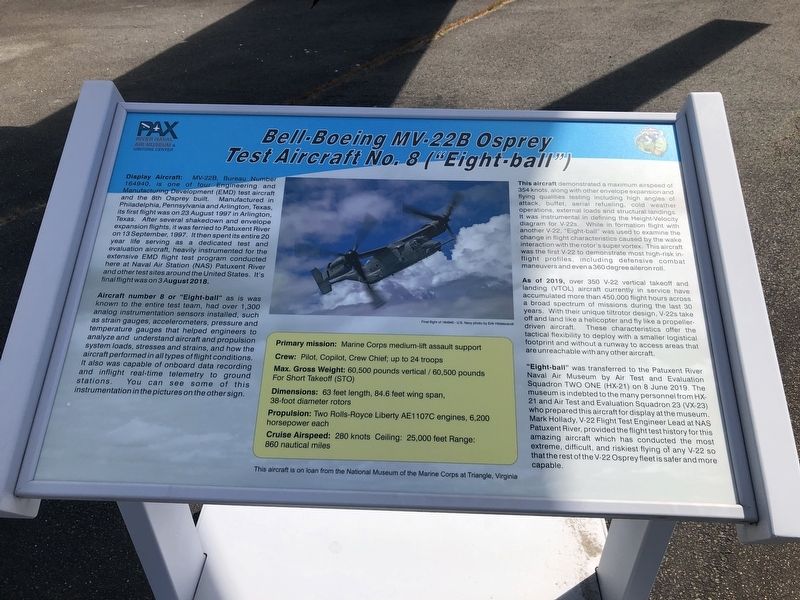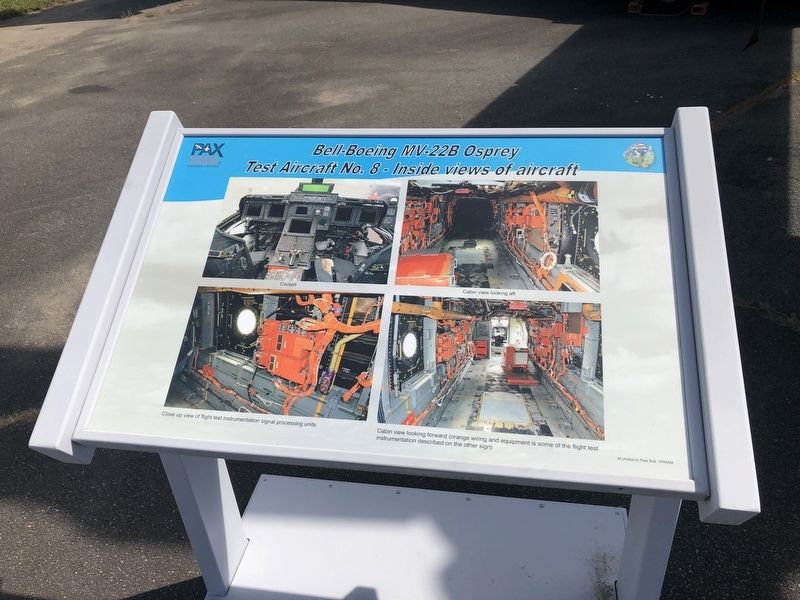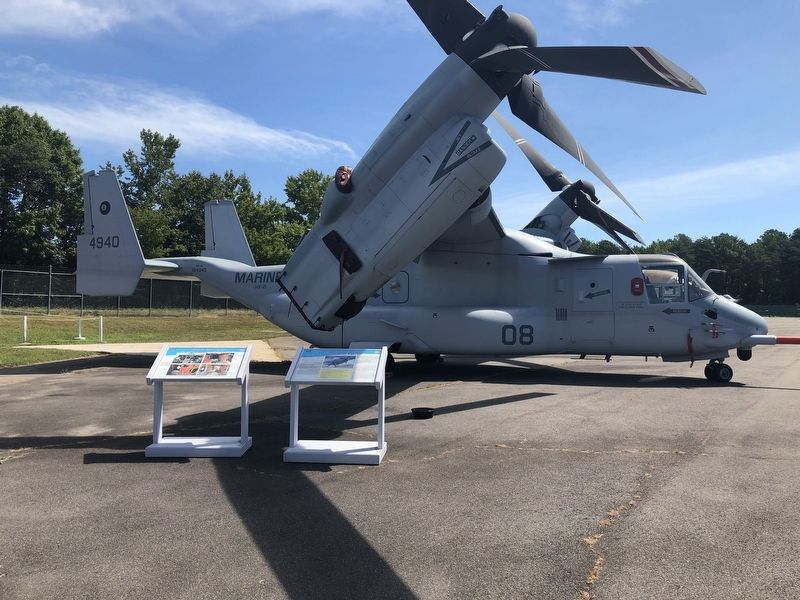Lexington Park in St. Mary's County, Maryland — The American Northeast (Mid-Atlantic)
Bell-Boeing MV-22B Osprey Test Aircraft No. 8 ("Eight-ball")

Photographed By Devry Becker Jones (CC0), August 30, 2019
1. Bell-Boeing MV-22B Osprey Test Aircraft No. 8 ("Eight-ball") Marker
Display Aircraft: MV-22B, Bureau Number 164940, is one of four Engineering and Manufacturing Development (EMD) test aircraft and the 8th Osprey built. Manufactured in Philadelphia, Pennsylvania and Arlington, Texas. Its first flight was on 23 August 1997 in Arlington, Texas. After several shakedown and envelop expansion flights, it was ferried to Patuxent River on 13 September, 1997. It then spent its entire 20 year life serving as a dedicated test and evaluation aircraft, heavily instrumented for the extensive EMD flight test program conducted here at Naval Air Station (NAS) Patuxent River and other test sites around the United States. It's final flight was on 3 August 2018.
Aircraft number 8 or "Eight-ball" as is was known to the entire test team, had over 1,300 analog instrumentation sensors installed, such as strain gauges, accelerometers, pressure and temperature gauges that helped engineers to analyze and understand aircraft and propulsion system loads, stresses and strains, and how the aircraft performed in all types of flight conditions. It also was capable of onboard data recording and inflight real-time telemetry to ground stations. You can see some of this instrumentation in the pictures on the other sign.
This aircraft demonstrated a maximum airspeed of 354 knots, along with other envelope expansion and flying qualities testing including high angles of attack, buffet, aerial refueling, cold weather operations, external loads and structural landings. It was instrumental in defining the Height-Velocity diagram for V-22s. While in formation flight with another V-22, "Eight-ball" was used to examine the change in flight characteristics caused by the wake interaction with the rotor's super vortex. This aircraft was the first V-22 to demonstrate most high-risk in-flight profiles, including defensive combat maneuvers and even a 360 degree aileron roll.
As of 2019, over 350 V-22 vertical takeoff and landing (VTOL) aircraft currently in service have accumulated more than 450,000 flight hours across a broad spectrum of missions during the last 30 years. With their unique tiltrotor design, V-22s take off and land like a helicopter and fly like a propeller-driven aircraft. These characteristics offer the tactical flexibility to deploy with a smaller logistical footprint and without a runway to access areas that are unreachable with any other aircraft.
"Eight-ball" was transferred to the Patuxent River Naval Air Museum by Air Test and Evaluation Squadron TWO ONE (HX-21) on 8 June 2019. The museum is indebted to the many personnel from HX-21 and Air Test and Evaluation Squadron 23 (VX-23) who prepared this aircraft for display

Photographed By Devry Becker Jones (CC0), August 30, 2019
2. Bell-Boeing MV-22B Osprey Test Aircraft No. 8 - Inside views of aircraft
• Primary mission: Marine Corps medium-lift assault support
• Crew: Pilot, Copilot, Crew Chief; up to 24 troops
• Max. Gross Weight: 60,500 pounds vertical / 60,500 pounds For Short Takeoff (STO)
• Dimensions: 63 feet length, 84.6 feet wing span, 38-foot diameter rotors
• Propulsion: Two Rolls-Royce Liberty AE1107C engines, 6,200 horsepower each
• Cruise Airspeed: 280 knots Ceiling: 25,000 feet Range: 860 nautical miles
Erected 2019 by Patuxent River Naval Air Museum.
Topics. This historical marker is listed in these topic lists: Air & Space • Military. A significant historical date for this entry is June 8, 2019.
Location. 38° 16.571′ N, 76° 27.755′ W. Marker is in Lexington Park, Maryland, in St. Mary's County. Marker can be reached from Three Notch Road (Maryland Route 235

Photographed By Devry Becker Jones (CC0), August 30, 2019
3. Bell-Boeing MV-22B Osprey Test Aircraft No. 8
Other nearby markers. At least 8 other markers are within walking distance of this marker. Grumman A-6 Intruder (a few steps from this marker); McDonnell Douglas AV-8B Harrier II (a few steps from this marker); Sikorsky CH-53A Sea Stallion (within shouting distance of this marker); NC-8A Mobile Electric Power Plant (MEPP) (within shouting distance of this marker); TA-75A Tow Tractor (within shouting distance of this marker); Beech T-34B Mentor (within shouting distance of this marker); Cedar Point Lighthouse (within shouting distance of this marker); Northrop Grumman EA-6B Prowler (within shouting distance of this marker). Touch for a list and map of all markers in Lexington Park.
Credits. This page was last revised on September 1, 2019. It was originally submitted on September 1, 2019, by Devry Becker Jones of Washington, District of Columbia. This page has been viewed 187 times since then and 14 times this year. Photos: 1, 2, 3. submitted on September 1, 2019, by Devry Becker Jones of Washington, District of Columbia.